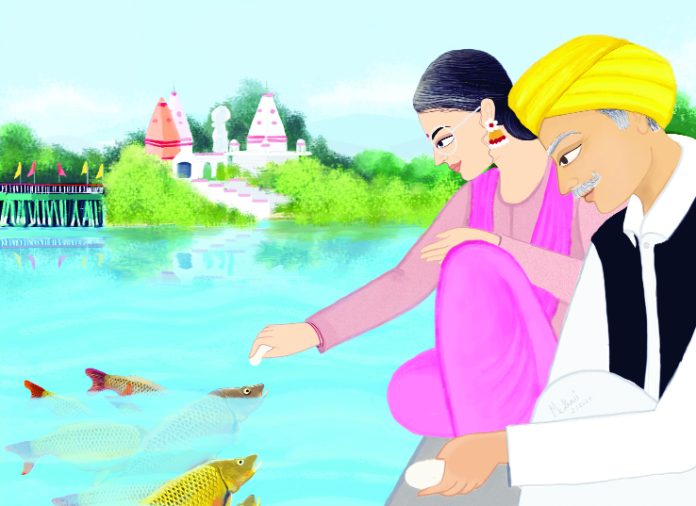Ashok Sharma
It is heartening to read that the text book of Dogri Part 2 (May, 2022 edition) for class 7 published by J& K Board of School Education, has incorporated, besides poems and other chapters, some chapters highlighting the local culture and heritage of Duggar and Ladakh.For instance, the Chapter 3 ‘Moungri Mela’ deals with famous mela ‘ Moungri Mela’ organised at pictursque Sar Dabbar located at a distance of 51Kms from Udhampur in village Kalsote in Tehsil Moungri District Udhampur. This three day Mela organised on first to 3rd Jyesth every year attracts visitors from the length and breadth of Jammu region and outside. This Mela having social and religious significance is organised in honour of Local Deity ‘ Kansar Devta’ at the confluence of two streams ‘Kalsote and Moungri. nestled in the pictursque and salubrious environs in the lap of Nature.
The Mela site is ideally located in the midst of tall mountains endowed with matchless and pristine beauty. A large no of people from Moungri, Panchari, Udhampur and other regions of our state and outside throng Sar Dabbar during the Mela to pay their obeisance to Lord Shiva, Goddess Parvati and other Deities in the natural caves having a naturally formed nine and a half feet Lingam guarded by Sheshnag and stone manifestations of Damru, Nandi and countless other Deities worth seeing at the site of the Mela in Moungri which is also the abode of widely revered Kansar Devta. The Mela attracts a large number of local artists and cultural troupes from other parts of the UT, who play melodious tunes on their flutes, present folk songs and folk dances such as kud, geetru, bhakhan etc. and leave the visitors mesmerised and spell bound. The local people, attired in colourful Dogra dresses and leaving behind their household chores, some of them carrying their kids on the shoulders, can be seen trekking for miles in groups on the uneven paths betwen the hills and stream to the mela site. It appears as if one has come into another world of colours and joy.
Various Government Departments also put up their stalls to aware the people about welfare and people friendly schemes launched by the Central and the State Government. Sports such as Kabaddi, tug of war, stone lifting and other fun filled activities are also organised with the active participation of the Department of Youth Services and Sports in collaboration with other departments. An Indian style wrestling match (Dangal), on the second or the concluding day of the Mela, is the star attraction of the Mela. Shopkeepers set up temporary shops of sweets, bangles, toys, food items etc and have a brisk business. District Administration Udhampur plays an important role in the successful organisation of this Mela. The District Administration arranges additional buses to the Mela site to cater to the demand of heavy rush of people for the Mela and makes elaborate arrangements of drinking water, security, power, sanitation, control on rates of various items etc to ensure that people do not face any problem at the Mela.
Chapter 5 on Ladakh, which is our neighbouring UT and part of erstwhile state of J&K, offers a glimpse into the climate, lifestyle, festivals, food, religious places, tourism etc of Ladakh while the Chapter 6 ‘Veer Sainik’ tells us the stories of valour & bravery of great warriors such as Brigadiar Rajinder Singh, Lance Naik Muhammad Khan, Col. Chewang Richen, Jamadar Prakash Singh, Brigadier Muhammad Hussain all of whom fought valiantly for the integrity of our nation and defending its bounderies.
Chapter 8 deals with ‘Mian Dido’ who is widely respected as a great warrior and local folk hero of Duggar. There are many folksongs called ‘ Baars’ sung in his honour. Similarly Chapter 9 pertains to ‘Duggar ki Chitarkala’ which highlights our rich heritage- the Basohli Paintings and great Dogra painters such as Nainsukh, Manak etc. Chapter 10 deals with Chanderbhaga, its origin, course and hydroelectric projects built on it. Chapter 12 highlights the famous tourist spots of Duggar such as Mansar, Surinsar, Patnitop, Sanasar and other favourite resorts thronged by tourists.
Chapter13 deals with Baba Chambliyal who is revered as much in India as in Pakistan and a Mela is organised on Baba Chambliyal shrine in Samba near Indo Pak Border, about 42Kms from Jammu. The concluding chapter deals with Dogri Proverbs and sayings which our young generation is hardly aware of. In short, the book aims to aquaint the young children with our culture, heritage, gallant heroes, natural resources and tourist spots, which will definitely kindle a quest in the students to appreciate their cultural heritage at young age and later strive to preserve and conserve it.
Trending Now
E-Paper


